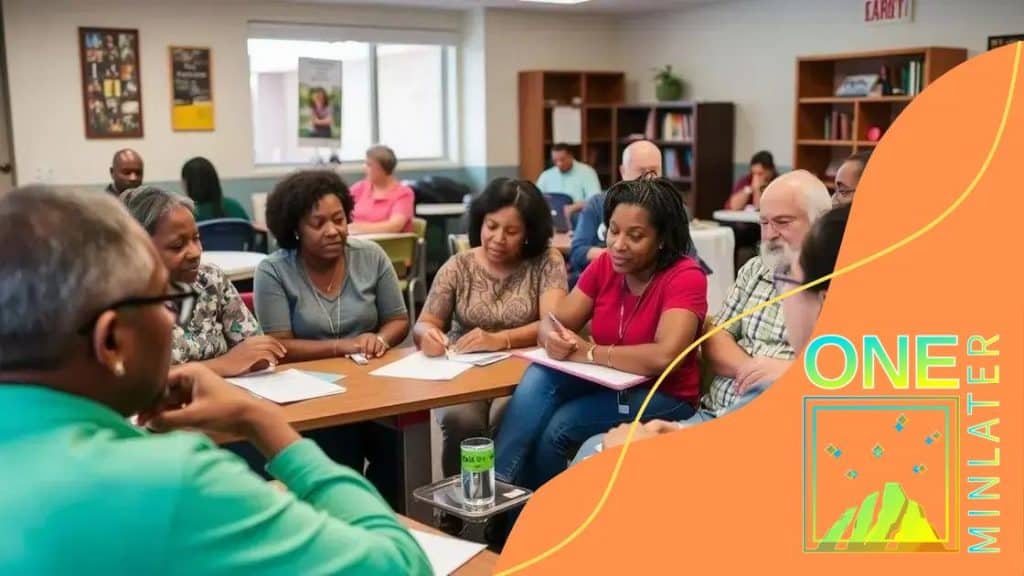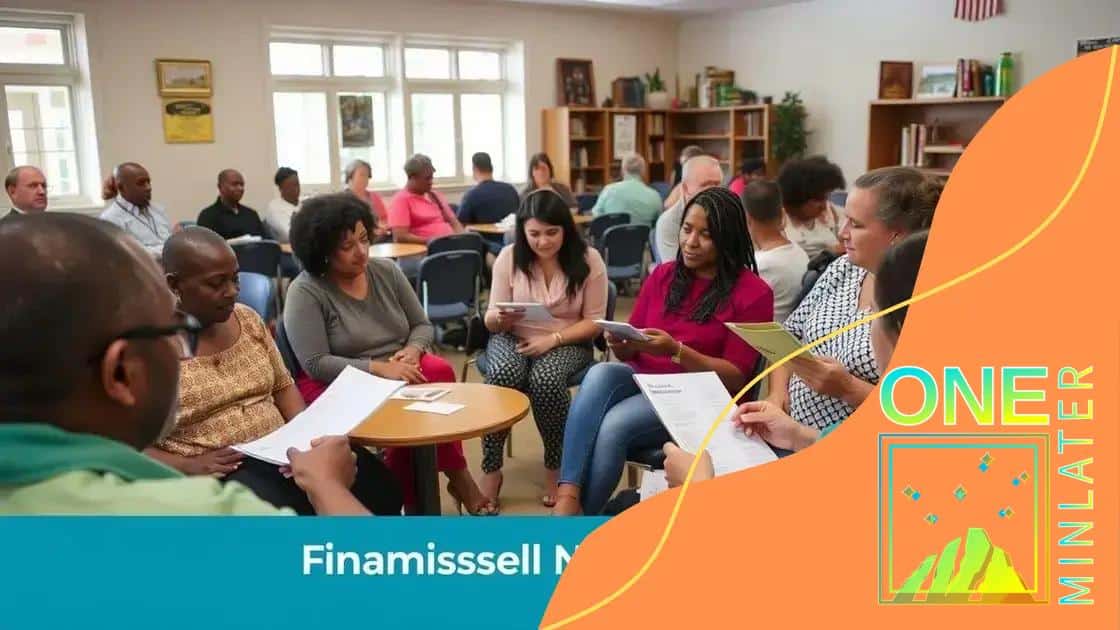Financial literacy programs for the unbanked population

Financial literacy programs for the unbanked population equip individuals with essential money management skills, addressing barriers such as resource limitations, cultural sensitivity, and engagement to promote better financial decision-making.
Financial literacy programs for the unbanked population hold the potential to transform lives. Have you ever wondered how financial education can open doors for those without traditional banking? Let’s dive into this vital topic and explore the possibilities.
Understanding the unbanked population
Understanding the unbanked population is crucial for developing effective financial literacy programs. Many individuals lack access to traditional banking services, which can limit their financial growth. Reasons for this can vary, including low income, lack of trust in financial institutions, or geographical barriers.
Characteristics of the Unbanked
The unbanked population often shares common traits that define their financial experiences. Recognizing these characteristics helps create targeted educational initiatives. For instance, a significant portion may not have a stable income or may work in cash-based jobs. They may also lack formal identification, which is often required to open bank accounts.
- Low income or unstable jobs
- Limited access to financial education
- Lack of trust in banks
- Difficulty obtaining necessary documents
Moreover, this group faces unique challenges when it comes to managing their finances. Without a bank account, individuals may resort to alternative financial services, which often have high fees and can lead to cycles of debt. Many individuals might not even know they have options available to them.
Impact on Financial Decisions
The absence of banking can impact their overall financial decision-making. Individuals might feel pressured to rely on cash, making budgeting a daunting task. Without a bank account, saving money can also become more challenging. How can someone save when they do not have a secure place for their funds?
This way of thinking can make financial stability seem out of reach. Emphasizing the importance of open conversations around finances can empower unbanked individuals. Through education, they can learn about savings, loans, and other essential financial concepts.
The importance of financial literacy
The importance of financial literacy cannot be overstated, especially for individuals in the unbanked population. Understanding basic financial concepts lays the groundwork for better money management. Without this knowledge, people may struggle to make informed decisions about their finances.
Empowerment through Knowledge
When individuals learn about financial topics, they gain control over their financial futures. Empowering themselves with knowledge allows them to set realistic goals. For many, learning how to budget, save, and invest can lead to improved financial stability.
- Budgeting effectively to monitor expenses
- Understanding the basics of loans and interest
- Recognizing the importance of saving for emergencies
- Making informed spending decisions
Financial literacy also encourages responsible behavior, helping individuals avoid pitfalls such as debt traps. When people are aware of how interest works, they become cautious about borrowing money. This knowledge can protect them from high-interest loans and credit card debt.
Building Financial Confidence
Having a solid understanding of finances boosts confidence. Financial literacy transforms anxiety about money into a proactive mindset. Individuals become more willing to explore banking options that best suit their needs. Not only does this lead to better financial outcomes, but it also creates opportunities for personal growth.
Moreover, as individuals become more financially literate, they may feel empowered to advocate for their financial needs better. They can participate in conversations about wealth-building strategies and engage with programs tailored to their financial situations. This engagement can further their understanding and lead to greater financial inclusion.
Key components of effective programs

The key components of effective financial literacy programs play a vital role in helping the unbanked population gain essential skills. A successful program combines various elements to maximize its impact and effectiveness.
Comprehensive Curriculum
First and foremost, a well-rounded curriculum is essential. Programs should cover topics like budgeting, saving, investing, and understanding credit. Participants benefit from learning how to set financial goals and develop actionable plans.
- Personal finance basics
- Strategies for budgeting and saving
- Understanding loans and interest rates
- Credit management and building credit history
Another critical aspect is making the curriculum relatable. Using real-life examples and case studies helps learners connect concepts to their own experiences. This approach not only improves comprehension but also encourages engagement.
Accessible Delivery Methods
Access to the program is equally important. Offering various formats such as workshops, online courses, and one-on-one coaching ensures that participants can choose what works best for them. Flexibility in scheduling allows more individuals to participate, which increases the program’s reach.
Additionally, culturally relevant materials enhance understanding. Tailoring content to the specific needs and backgrounds of participants can boost overall effectiveness. This customization helps learners feel valued and understood.
Ongoing Support and Resources
Providing ongoing support is crucial for long-term success. Programs should offer follow-up sessions or refresher courses to reinforce knowledge. Furthermore, access to financial resources, such as tools and software, can aid participants in managing their finances effectively. Building a supportive community can help individuals stay motivated on their financial journeys.
Mentorship opportunities also play a significant role. Pairing participants with mentors who have successfully navigated financial challenges can inspire hope and provide practical advice. This connection fosters a sense of belonging and accountability, which can be powerful motivators.
Successful case studies
Successful case studies in financial literacy programs provide valuable insights into what works best for the unbanked population. These real-life examples showcase how targeted education can have a lasting impact.
Case Study 1: Community Action Program
One notable program is the Community Action Program in a small urban area. This initiative focused on providing hands-on workshops in local community centers. Participants learned about budgeting, saving, and the benefits of having a bank account.
- Participants reported a significant increase in savings after completing the program.
- Many began using banks instead of relying on cash or check cashing services.
- Feedback showed that the hands-on approach made learning engaging and effective.
Through this program, participants gained confidence in their financial choices, which helped them move toward stability.
Case Study 2: Mobile Financial Literacy Van
Another success is the Mobile Financial Literacy Van initiative. This program brought financial education directly to underserved neighborhoods. The van traveled to various locations, offering workshops on essential financial topics.
The flexibility of this approach allowed more people to participate since they did not need to travel far. Participants appreciated the accessibility and convenience. Follow-up surveys revealed that:
- Over 70% of participants felt more knowledgeable about managing money.
- Many started opening bank accounts after attending sessions.
- The program encouraged ongoing financial discussions within families.
This model demonstrated the effectiveness of taking financial literacy directly into communities.
Case Study 3: Partnership with Local Businesses
Furthermore, a partnership between local businesses and a financial literacy organization resulted in an engaging program that combined education with incentives. Participants received lessons on financial planning and, in return, businesses offered discounts on products and services for completing the program.
The appeal of discounts enhanced participation. Many participants expressed satisfaction with learning new skills while also saving money. This collaboration fostered a sense of community and trust between local businesses and residents.
These case studies illustrate that thoughtful, community-oriented approaches can effectively equip the unbanked population with critical financial skills. By examining these successes, other organizations can adapt and implement similar strategies to help those in need.
Challenges in implementing financial literacy
Implementing financial literacy programs comes with various challenges. These hurdles can impede the effectiveness of the initiatives designed to help the unbanked population. Understanding these challenges is key to developing successful programs.
Identifying the Target Audience
One major challenge is identifying the right target audience. Many individuals in the unbanked population may not see the value in financial education. A lack of awareness about existing programs can create barriers to participation. Therefore, organizations must work hard to reach out and engage the community.
- Creating awareness through local events
- Using social media to connect with potential participants
- Collaborating with community leaders
These efforts can lead to increased interest, but they require strategic planning and resources.
Resource Limitations
Another significant challenge is resource limitations. Many organizations may lack the funding or personnel needed to run effective programs. This can result in fewer workshops or limited access to educational materials. Without adequate resources, the quality of the program suffers.
To combat these limitations, organizations can:
- Seek partnerships with local businesses and nonprofits
- Apply for grants targeted at community education
- Utilize volunteers who are passionate about financial literacy
Such collaborations can help bridge the gap and enhance program offerings.
Cultural Sensitivity and Engagement
Cultural sensitivity is another challenge. Financial concepts may not resonate with everyone, especially in diverse communities. Programs must consider cultural differences and tailor content accordingly. Engaging participants in ways that respect their values is crucial.
Organizations can empower their initiatives by:
- Incorporating cultural examples in financial education
- Listening to community feedback
- Adapting teaching methods to suit learning styles
Through thoughtful engagement, programs can present financial literacy in a relatable way.
Measuring Impact
Lastly, measuring the impact of financial literacy programs is challenging. Without proper metrics, it can be difficult to assess whether the program is meeting its goals. Organizations need to develop clear metrics to evaluate success. This can include tracking participant progress, behavioral changes, and overall financial improvements.
By addressing these challenges, organizations can better support the unbanked population in achieving financial empowerment. While hurdles exist, innovative solutions can lead to more effective programs and positive outcomes for participants.
FAQ – Frequently Asked Questions about Financial Literacy Programs
What are financial literacy programs?
Financial literacy programs are educational initiatives designed to help individuals understand financial concepts, improve money management skills, and make informed financial decisions.
Who can benefit from financial literacy programs?
Anyone can benefit from financial literacy programs, but they are especially important for the unbanked population, who may lack access to traditional financial services.
What topics are typically covered in these programs?
Common topics include budgeting, saving, understanding credit, investing, and financial planning strategies.
What challenges do organizations face when implementing these programs?
Organizations may face challenges such as identifying the target audience, securing sufficient resources, ensuring cultural sensitivity, and measuring program impact.





